List of cities and towns of Hungary

Hungary has 3,152 localities as of July 15, 2013: 346 towns (Hungarian term: város, plural: városok; the terminology doesn't distinguish between cities and towns – the term town is used in official translations) and 2,806 villages (Hungarian: község, plural: községek). The number of towns can change, since villages can be elevated to town status by act of the President. The capital Budapest has a special status and is not included in any county while 23 of the towns are so-called urban counties (megyei jogú város – town with county rights). All county seats except Budapest are urban counties.
Four of the cities (Budapest, Miskolc, Győr, and Pécs) have agglomerations, and the Hungarian Statistical Office distinguishes seventeen other areas in earlier stages of agglomeration development.[1][permanent dead link]
The largest city is the capital, Budapest, while the smallest town is Pálháza with 1038 inhabitants (2010). The largest village is Solymár (population: 10,123 as of 2010). There are more than 100 villages with fewer than 100 inhabitants while the smallest villages have fewer than 20 inhabitants.
Largest cities in Hungary[]
Bold: Town with county rights (megyei jogú város).
Over 100,000 (big cities)[]
| City / town | County | Population | Peak population | Metropolitan area (2020) | ||||
|---|---|---|---|---|---|---|---|---|
| 1949 Census | 1990 Census | 2011 Census | 2021 Estimate | |||||
| 1. | Budapest | Budapest (Pest) | 1,590,316 | 2,016,681 | 1,733,685 | 1,723,836 |
2,113,034 (1989) | 3,014,944 |
| 2. | Debrecen | Hajdú-Bihar | 115,399 | 212,235 | 211,340 | 200,974 |
217,706 (1994) | 325,326 |
| 3. | Szeged | Csongrád-Csanád | 104,867 | 175,301 | 168,048 | 159,074 |
178,878 (1994) | 242,326 |
| 4. | Miskolc | Borsod-Abaúj-Zemplén | 109,841 | 196,442 | 167,754 | 150,695 |
211,345 (1985) | 283,706 |
| 5. | Pécs | Baranya | 89,470 | 170,039 | 156,049 | 140,237 |
172,177 (1994) | 245,194 |
| 6. | Győr | Győr-Moson-Sopron | 69,583 | 129,331 | 129,527 | 132,735 |
133,946 (2020) | 260,024 |
| 7. | Nyíregyháza | Szabolcs-Szatmár-Bereg | 56,334 | 114,152 | 119,746 | 116,554 |
119,746 (2011) | 233,623 |
| 8. | Kecskemét | Bács-Kiskun | 61,730 | 102,516 | 111,411 | 109,651 |
112,233 (2010) | 201,156 |
| Sources:[2][3] | ||||||||

 Budapest
Budapest
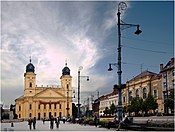
 Debrecen
Debrecen
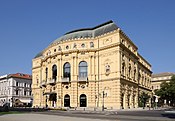
 Szeged
Szeged
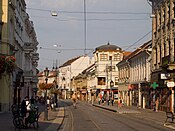
 Miskolc
Miskolc

 Pécs
Pécs
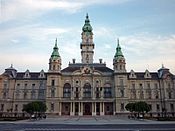
 Győr
Győr

 Nyíregyháza
Nyíregyháza

 Kecskemét
Kecskemét
50,000–100,000 (medium-sized cities)[]
| City / town | County | Population | Top population | Metropolitan area (2020) | ||||
|---|---|---|---|---|---|---|---|---|
| 1949 Census | 1990 Census | 2011 Census | 2021 Estimate | |||||
| 9. | Székesfehérvár | Fejér | 42,260 | 108,958 | 100,570 | 95,545 |
109,762 (1993) | 271,674 |
| 10. | Szombathely | Vas | 47,589 | 85,617 | 78,884 | 78,324 |
85,932 (1994) | 148,880 |
| 11. | Érd | Pest | 16,444 | 43,327 | 63,631 | 70,063 |
70,063 (2021) | Budapest |
| 12. | Szolnok | Jász-Nagykun-Szolnok | 37,520 | 78,328 | 72,953 | 69,725 |
80,859 (1994) | 157,174 |
| 13. | Tatabánya | Komárom-Esztergom | 40,221 | 74,277 | 67,753 | 65,145 |
75,921 (1980) | - |
| 14. | Sopron | Győr-Moson-Sopron | 36,506 | 55,083 | 60,548 | 62,900 |
63,065 (2020) | - |
| 15. | Kaposvár | Somogy | 37,945 | 71,788 | 66,245 | 59,777 |
74,101 (1979) | - |
| 16. | Veszprém | Veszprém | 20,682 | 63,867 | 61,721 | 58,153 |
65,789 (1994) | - |
| 17. | Békéscsaba | Békés | 44,053 | 67,157 | 62,050 | 58,002 |
68,044 (1980) | - |
| 18. | Zalaegerszeg | Zala | 21,668 | 62,212 | 59,499 | 55,470 |
62,908 (1994) | - |
| 19. | Eger | Heves | 32,352 | 61,892 | 56,569 | 51,168 |
63,794 (1994) | - |
| Source:[3] | ||||||||
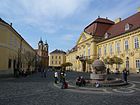
 Székesfehérvár
Székesfehérvár

 Szombathely
Szombathely

 Szolnok
Szolnok

 Érd
Érd
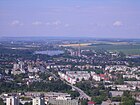
 Tatabánya
Tatabánya
 Sopron
Sopron

 Kaposvár
Kaposvár

 Veszprém
Veszprém

 Békéscsaba
Békéscsaba

 Zalaegerszeg
Zalaegerszeg

 Eger
Eger
30,000–50,000 (towns)[]
| City / town | County | Population | Top population | Metropolitan area (2021) | ||||
|---|---|---|---|---|---|---|---|---|
| 1949 Census | 2011 Census | 2021 Estimate | ||||||
| 20. | Nagykanizsa | Zala | 33,158 | 49,026 | 45,428 |
54,052 (1990) | - | |
| 21. | Dunakeszi | Pest | 11,029 | 40,545 | 43,990 |
43,990 (2021) | Budapest | |
| 22. | Hódmezővásárhely | Csongrád-Csanád | 49,417 | 46,047 | 42,691 |
54,486 (1980) | Szeged | |
| 23. | Dunaújváros | Fejér | 3,949 | 48,484 | 42,136 |
60,736 (1980) | - | |
| 24. | Szigetszentmiklós | Pest | 5,865 | 34,708 | 40,519 |
40,519 (2021) | Budapest | |
| 25. | Cegléd | Pest | 35,237 | 36,645 | 35,334 |
40,644 (1980) | - | |
| 26. | Mosonmagyaróvár | Győr-Moson-Sopron | 16,546 | 32,004 | 34,439 |
34,439 (2021) | - | |
| 27. | Baja | Bács-Kiskun | 27,936 | 36,267 | 33,893 |
39,822 (1994) | - | |
| 28. | Vác | Pest | 21,287 | 33,831 | 32,927 |
34,866 (1980) | Budapest | |
| 29. | Salgótarján | Nógrád | 32,571 | 37,262 | 32,304 |
50,120 (1980) | - | |
| 30. | Gödöllő | Pest | 12,216 | 32,522 | 31,779 |
32,437 (2016) | Budapest | |
| 31. | Ózd | Borsod-Abaúj-Zemplén | 29,184 | 34,481 | 31,234 |
48,636 (1981) | - | |
| 32. | Szekszárd | Tolna | 16,354 | 34,296 | 30,963 |
39,005 (1989) | - | |
| 33. | Hajdúböszörmény | Hajdú-Bihar | 30,315 | 31,725 | 29,962 |
33,685 (1960) | - | |
| 34. | Pápa | Veszprém | 24,291 | 31,845 | 29,387 |
33,846 (1990) | - | |
| Source:[3] | ||||||||

 Nagykanizsa
Nagykanizsa
 Dunaújváros
Dunaújváros

 Hódmezővásárhely
Hódmezővásárhely

 Dunakeszi
Dunakeszi

 Szigetszentmiklós
Szigetszentmiklós

 Cegléd
Cegléd

 Baja
Baja

 Salgótarján
Salgótarján

 Ózd
Ózd
 Vác
Vác

 Mosonmagyaróvár
Mosonmagyaróvár

 Szekszárd
Szekszárd

 Gödöllő
Gödöllő

 Pápa
Pápa
 Hajdúböszörmény
Hajdúböszörmény

 Gyula
Gyula

 Gyöngyös
Gyöngyös
 Kiskunfélegyháza
Kiskunfélegyháza

 Budaörs
Budaörs

 Ajka
Ajka

 Orosháza
Orosháza

 Esztergom
Esztergom

 Szentes
Szentes

 Kiskunhalas
Kiskunhalas

 Kazincbarcika
Kazincbarcika

 Jászberény
Jászberény

 Szentendre
Szentendre

 Siófok
Siófok
All other towns in Hungary[]
Sources:[3][4] 25,000 – 15,000
- Hajdúszoboszló (23,735)
- Nagykőrös (23,589)
- Tata (23,445)
- Komló (23,388)
- Gyál (23,152)
- Makó (22,747)
- Dunaharaszti (21,018)
- Vecsés (20,673)
- Törökszentmiklós (20,323)
- Hatvan (20,250)
- Karcag (20,025)
- Keszthely (19,910)
- Várpalota (19,640)
- Békés (19,243)
- Fót (19,216)
- Paks (19,117)
- Komárom (18,786)
- Százhalombatta (18,599)
- Dombóvár (18,461)
- Göd (18,351)
- Oroszlány (17,983)
- Monor (17,960)
- Veresegyház (17,532)
- Balmazújváros (17,421)
- Mohács (17,355)
- Gyömrő (17,236)
- Szigethalom (17,156)
- Hajdúnánás (17,038)
- Mátészalka (16,864)
- Pomáz (16,764)
- Dabas (16,728)
- Mezőtúr (16,502)
- Kisvárda (16,489)
- Mezőkövesd (16,310)
- Csongrád (16,277)
- Szarvas (16,044)
- Kalocsa (15,986)
- Tiszaújváros (15,954)
- Pécel (15,494)
- Tapolca (15,459)
- Balassagyarmat (15,280)
15,000 – 5,000
- Berettyóújfalu (14,816)
- Sárvár (14,797)
- Sátoraljaújhely (14,703)
- Püspökladány (14,511)
- Abony (14,508)
- Kiskőrös (14,109)
- Mór (14,010)
- Budakeszi (13,939)
- Pilisvörösvár (13,903)
- Törökbálint (13,385)
- Bonyhád (13,322)
- Gyomaendrőd (13,133)
- Hajdúsámson (13,039)
- Balatonfüred (13,038)
- Biatorbágy (12,932)
- Tiszavasvári (12,818)
- Hajdúhadház (12,747)
- Újfehértó (12,607)
- Gárdony (12,600)
- Nagykáta (12,384)
- Kistarcsa (12,383)
- Bátonyterenye (12,221)
- Albertirsa (12,188)
- Nyírbátor (12,146)
- Sárospatak (12,067)
- Sárbogárd (12,038)
- Maglód (12,037)
- Bicske (11,984)
- Dorog (11,855)
- Üllő (11,774)
- Tiszakécske (11,743)
- Kőszeg (11,730)
- Pilis (11,518)
- Sajószentpéter (11,491)
- Körmend (11,419)
- Marcali (11,352)
- Lajosmizse (11,342)
- Isaszeg (11,264)
- Kiskunmajsa (11,216)
- Kisújszállás (11,182)
- Tiszafüred (11,091)
- Tolna (11,080)
- Celldömölk (10,827)
- Tiszaföldvár (10,741)
- Barcs (10,698)
- Budakalász (10,673)
- Szigetvár (10,585)
- Heves (10,475)
- Nagyatád (10,468)
- Kapuvár (10,431)
- Csorna (10,406)
- Tököl (10,168)
- Mezőberény (10,148)
- Ráckeve (10,069)
- Kerepes (9,904)
- Sarkad (9,808)
- Halásztelek (9,758)
- Edelény (9,516)
- Ócsa (9,247)
- Pásztó (9,212)
- Nagykálló (9,211)
- Siklós (9,147)
- Szeghalom (9,005)
- Szerencs (8,942)
- Szentgotthárd (8,872)
- Vásárosnamény (8,766)
- Nádudvar (8,697)
- Hajdúdorog (8,622)
- Derecske (8,612)
- Balatonalmádi (8,564)
- Túrkeve (8,563)
- Jánoshalma (8,530)
- Dunaföldvár (8,501)
- Kecel (8,445)
- Jászapáti (8,442)
- Kunszentmárton (8,324)
- Kunszentmiklós (8,309)
- Tamási (8,068)
- Fehérgyarmat (8,042)
- Ercsi (7,981)
- Polgár (7,908)
- Sándorfalva (7,772)
- Jászárokszállás (7,756)
- Dévaványa (7,747)
- Nyíradony (7,714)
- Tura (7,689)
- Dunavarsány (7,659)
- Kunhegyes (7,645)
- Füzesabony (7,527)
- Soltvadkert (7,405)
- Nyergesújfalu (7,378)
- Lenti (7,348)
- Létavértes (7,108)
- Kistelek (6,968)
- Zirc (6,899)
- Polgárdi (6,856)
- Ács (6,793)
- Vésztő (6,784)
- Mindszent (6,674)
- Ibrány (6,662)
- Enying (6,651)
- Putnok (6,609)
- Nyírtelek (6,535)
- Bácsalmás (6,496)
- Felsőzsolca (6,486)
- Kerekegyháza (6,470)
- Zalaszentgrót (6,448)
- Balkány (6,413)
- Szentlőrinc (6,401)
- Fegyvernek (6,324)
- Téglás (6,321)
- Nagyecsed (6,317)
- Solt (6,312)
- Encs (6,297)
- Martfű (6,237)
- Aszód (6,160)
- Sümeg (6,133)
- Bátaszék (6,118)
- Szabadszállás (6,116)
- Jánossomorja (6,099)
- Mezőkovácsháza (6,059)
- Újszász (6,054)
- Mórahalom (6,017)
- Kozármisleny (5,981)
- Tótkomlós (5,902)
- Szécsény (5,883)
- Tápiószele (5,869)
- Pusztaszabolcs (5,847)
- Battonya (5,835)
- Mezőcsát (5,826)
- Kaba (5,807)
- Berhida (5,785)
- Füzesgyarmat (5,752)
- Balatonboglár (5,673)
- Nagyhalász (5,660)
- Velence (5,619)
- Izsák (5,617)
- Alsózsolca (5,606)
- Jászfényszaru
- Martonvásár (5,592)
- Lőrinci (5,446)
- Zsámbék (5,368)
- Kisbér (5,357)
- Jászkisér (5,349)
- Komádi (5,341)
- Vámospércs (5,322)
- Szikszó (5,307)
- Tiszalök (5,305)
- Mezőhegyes (5,274)
- Rákóczifalva (5,266)
- Csákvár (5,253)
- Tát (5,241)
- Balatonlelle (5,235)
- Újkígyós (5,009)
< 5,000
- Csurgó (4,932)
- Nyékládháza (4,865)
- Mélykút (4,841)
- Nyírmada (4,839)
- Csenger (4,820)
- Kemecse (4,811)
- Lábatlan (4,794)
- Csorvás (4,789)
- Emőd (4,761)
- Örkény (4,748)
- Fonyód (4,745)
- Hévíz (4,721)
- Nagymaros (4,717)
- Tiszacsege (4,684)
- Elek (4,659)
- Rácalmás (4,561)
- Körösladány (4,476)
- Aba (4,424)
- Kenderes (4,437)
- Tompa (4,413)
- Rakamaz (4,338)
- Harkány (4,303)
- Tab (4,301)
- Tokaj (4,282)
- Szendrő (4,249)
- Devecser (4,246)
- Záhony (4,237)
- Vasvár (4,229)
- Demecser (4,173)
- Abádszalók (4,160)
- Biharkeresztes (4,147)
- Mándok (4,094)
- Balatonfűzfő (4,084)
- Tét (4,062)
- Letenye (4,060)
- Bodajk (4,015)
- Pannonhalma (4,001)
- Pécsvárad (3,994)
- Simontornya (3,986)
- Dombrád (3,964)
- Baktalórántháza (3,954)
- Bóly (3,874)
- Fertőszentmiklós (3,864)
- Bábolna (3,840)
- Dunavecse (3,824)
- Verpelét (3,800)
- Mezőkeresztes (3,746)
- Ajak (3,709)
- Adony (3,686)
- Bük (3,579)
- Vaja (3,534)
- Medgyesegyháza (3,527)
- Fertőd (3,396)
- Herend (3,367)
- Nagybajom (3,309)
- Csepreg (3,272)
- Vép (3,266)
- Besenyszög (3,240)
- Lébény (3,229)
- Borsodnádasd (3,185)
- Cigánd (3,058)
- Sásd (3,053)
- Abaújszántó (3,021)
- Hajós (3,013)
- Bélapátfalva (2,979)
- Lengyeltóti (2,952)
- Zalalövő (2,945)
- Kisköre (2,870)
- Csanádpalota (2,801)
- Sajóbábony (2,761)
- Rétság (2,722)
- Nyírlugos (2,683)
- Szob (2,660)
- Beled (2,632)
- Répcelak (2,625)
- Balatonkenese (2,554)
- Sellye (2,548)
- Jánosháza (2,461)
- Gyöngyöspata (2,459)
- Rudabánya (2,458)
- Zamárdi (2,422)
- Kadarkút (2,418)
- Villány (2,406)
- Mágocs (2,316)
- Nagymányok (2,233)
- Balatonföldvár (2,150)
- Máriapócs (2,136)
- Badacsonytomaj (2,077)
- Pétervására (2,065)
- Gönc (2,053)
- Gyönk (1,999)
- Zalakaros (1,939)
- Visegrád (1,842)
- Pacsa (1,610)
- Igal (1,327)
- Őriszentpéter (1,154)
- Pálháza (1,050)
Largest cities in Hungary in 1910[]
In 1910, the ten largest cities in the Kingdom of Hungary (including Croatia-Slavonia) were:[5]
- 1. Budapest (the capital of Hungary): 880,371
- 2. Szeged: 118,328
- 3. Szabadka (now located in Serbia): 94,610
- 4. Debreczen: 92,729
- 5. Zágráb (then located in the Kingdom of Croatia-Slavonia, today in Croatia): 79,038
- 6. Pozsony (now located in Slovakia): 78,223
- 7. Temesvár (now located in Romania): 72,555
- 8. Kecskemét: 66,834
- 9. Arad (now located in Romania): 63,166
- 10. Hódmező Vásárhely: 62,445
Out of Hungary's ten largest cities in 1910, five are now located outside of Hungary as a result of post-World War I border changes.
See also[]
- Regions of Hungary
- Counties of Hungary
- Districts of Hungary (from 2013)
- Subregions of Hungary (until 2013)
- Administrative divisions of the Kingdom of Hungary (until 1918)
- Counties of the Kingdom of Hungary
- Administrative divisions of the Kingdom of Hungary (1941–44)
- NUTS:HU
References[]
- ^ "Ter leti atlasz - Interakt v tematikus". portal.ksh.hu. Archived from the original on 2006-03-19.
- ^ "Magyarország közigazgatási helynévkönyve, 2012. január 1" [Gazetteer of Hungary, 1st January 2012] (PDF). Hungarian Central Statistical Office. Retrieved 2022-02-22.
- ^ a b c d "Localities 01.01.2021". Hungarian Central Statistical Office. Retrieved 2022-02-22.
- ^ "List of localities in alphabetical order". Hungarian Central Statistical Office. Retrieved 2022-02-22.
- ^ "The Chicago Daily News Almanac and Year Book for ... - Google Books". 1918. Retrieved 2019-04-05.
External links[]
- Lists of cities in Europe
- Demographics of Hungary
- Lists of cities by country
- Populated places in Hungary
- Lists of populated places in Hungary
- Cities in Hungary
- Towns in Hungary















































